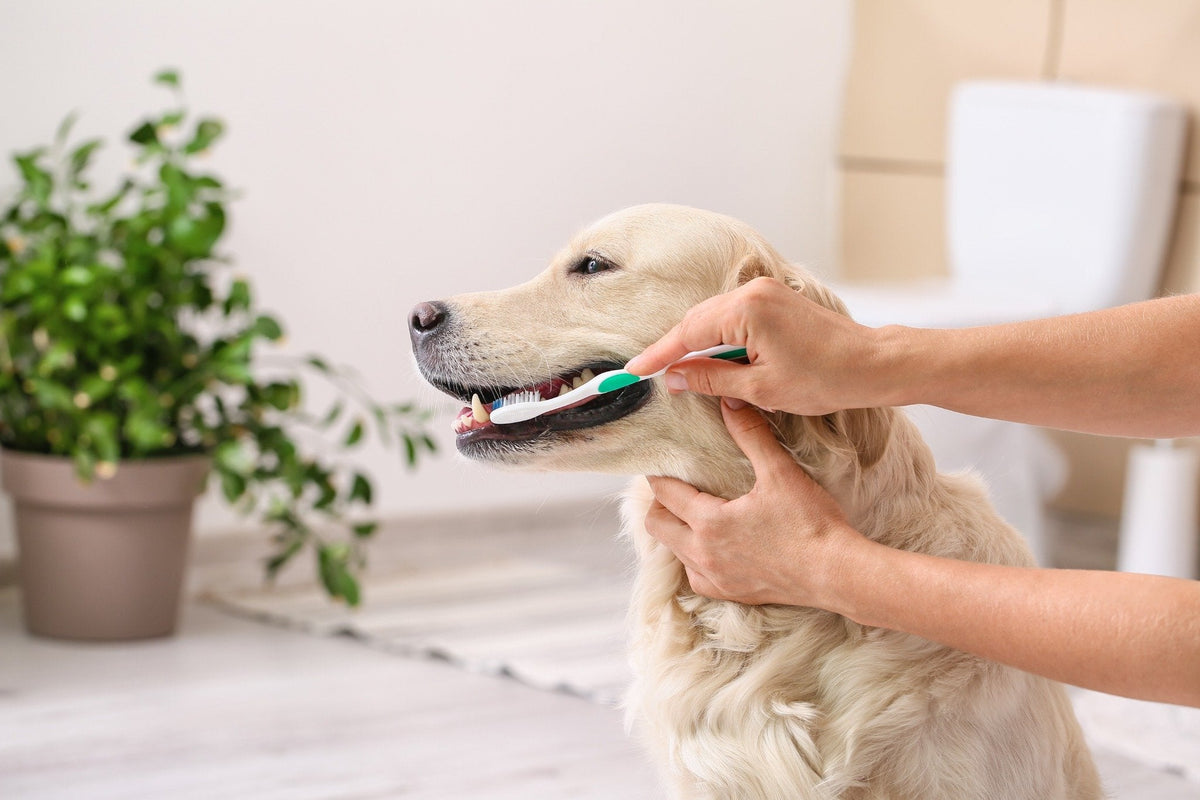
How To Remove Plaque From A Dog's Teeth
|
|
Plaque on your dog’s teeth is one of the first signs of dental disease, which can lead to bad dog breath.
More importantly, dental disease can also cause your dog pain, stop them from eating, or put them at risk of other health conditions.
But how do you get rid of plaque on your dog’s teeth?
Let’s find out.
Plaque is a mixture of saliva, bacteria, and debris like small food particles.
It coats all surfaces in the mouth, including the teeth, and forms a biofilm where the bacteria thrive.
The bacteria can cause a foul smell, but they can also cause inflammation of the gums and ligaments that protect the tooth root and secure it in the socket.
Over time, the plaque mineralises to form tartar (also known as calculus).
This causes further damage to the gums, exposing more of the tooth root and allowing bacteria to penetrate further, leading to pain, infection, and wobbly teeth.
Plaque on dogs’ teeth can cause no symptoms at all, especially if it’s mild.
But you might notice the following signs:
As the dental disease progresses and the plaque becomes tartar, you might notice a grey or brown coating forming on the teeth.
At this point, more bacteria become trapped, worsening the smell and other symptoms and risking tooth loss over time.
You might be wondering why you should bother removing your dog’s dental plaque if it’s the tartar that causes the majority of the damage.
However, dog tartar removal can only be performed by veterinary staff under anaesthetic, and by the time the tartar has formed, the tooth and surrounding gum will already be affected by irreversible damage.
That’s why we recommend removing dog plaque before it becomes tartar, just like brushing our teeth twice daily.
There are several ways that can help remove plaque from a dog's teeth.
If you can, use a combination of all these, but if your dog won’t tolerate toothbrushing at all, focusing on the other methods will still help.
Brushing your dog’s teeth is the most effective way to remove plaque.
Ideally, you should brush their teeth daily or every other day, as larger gaps between brushing will allow the plaque to form again and begin to cause problems.
Use a pet-safe toothpaste in a flavour that your dog loves, and choose a finger brush or handheld brush, depending on what works best for you both.
Check out this handy Dog Toothbrushing Guide from the Dogs Trust to help get you started or refresh your technique.
Dental treats and chews, bones, and rawhide chews have all been suggested for dog plaque removal.
However, unless the chew is natural and healthy, it’s likely to contain lots of calories or fat, meaning it could make your dog gain weight.
Rawhide chews and bones can be even more dangerous, risking gut damage, blockages, or broken teeth. Learn more from our blog on the dangers of rawhide.
Carrots are a great natural chew option, as they act as a safe and healthy dental plaque remover.
It’s important to remember the importance of good nutrition to keep your dog healthy from their teeth to their toes.
Our fresh dog food is packed with nutrient-rich vegetables, specifically designed to support your dog's oral and overall health.
Our meals contain crunchy fruit and vegetables to help remove plaque, as well as turmeric to reduce inflammation and coconut oil to reduce bacteria and freshen their breath.
Years Plaque Guard
Years offers a dental defence supplement formulated to provide your dog with cleaner teeth, healthier gums and fresher breath.
Scientifically proven to fight plaque and freshen breath with powerful antioxidants and antimicrobials.
Years' subscribers can add this to their next order through their account.
Every dog is affected by plaque and tartar at some point.
However, certain dogs are more likely to have plaque and dental disease.
First, senior dogs very often have plaque and tartar, because they have lived longer and dental disease worsens over time.
Second, small breed dogs like Chihuahuas and Yorkshire Terriers are prone to plaque issues because they have small mouths with lots of teeth.
This means there’s less airflow so bacteria thrive, and it’s also harder to access the back of their mouth with a toothbrush.
Finally, brachycephalic dogs (short-nosed, flat-faced breeds) like the French Bulldog and Pug are prone to dental disease too.
Again, this is because they have so many teeth in a small area, but in these breeds, the teeth are often overcrowded and poorly aligned, leading to more nooks and crannies for bacteria to hide.
Keeping your dog's teeth clean is no easy feat but I hope these ideas help you to keep their mouth as healthy and comfortable as possible.

